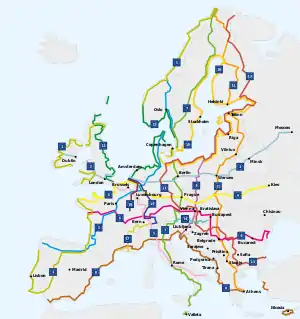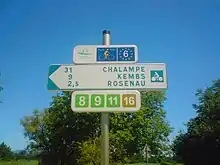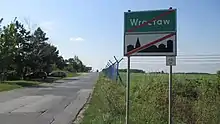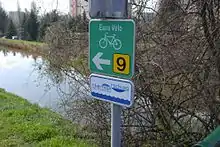EuroVelo
EuroVelo is a network of currently 17 long-distance cycling routes criss-crossing Europe, in various stages of completion. When completed, the EuroVelo network's total length will almost be 90,000 km (55,923 mi).[1][2] As of November 2019 more than 45,000 km (27,962 mi) were in place.[3] EuroVelo is a project of the European Cyclists' Federation (ECF).

EuroVelo routes can be used for bicycle touring across the continent, as well as by local people making short journeys. The routes are made of both existing national bike routes — such as the Dutch LF-Routes, the German D-Routes, and the British National Cycle Network — and existing general purpose roads, together with new stretches of cycle routes to connect them.[4]
History
The idea of creating a network of international cycle routes spanning Europe started in 1995. It was initially coordinated by the ECF, De Frie Fugle (Denmark) and Sustrans (UK) and the original plan was to create 12 long-distance cycling routes.
Since August 2007, the ECF has assumed full responsibility for the project. Despite sometimes tight financial constraints, the EuroVelo project has already begun to fulfil the vision of its founders with sections of the network being implemented in countries as far apart as Finland, Cyprus, Spain and the UK. In addition, the EuroVelo brand has become widely known and is increasingly seen as a sign of quality.
There have been various changes to the network over the years, most notably the addition of two new routes — EuroVelo 13 (the Iron Curtain Trail) and EuroVelo 15 (the Rhine Cycle Route) — in September 2011, which are the longest and shortest of the EuroVelo routes.[5]
Main points on the EuroVelo routes
| Route number | Route name | Passes through these cities | Through these countries | Length | |
|---|---|---|---|---|---|
| km | mi | ||||
| EV1 | Atlantic Coast Route | North Cape (EV7, EV11) - Norwegian Coast - Trondheim (EV3) - Bergen (EV12) - Aberdeen (EV12) - Inverness (EV12 ) - Glasgow - Stranraer - Belfast - Galway (EV2) - Cork - Rosslare - Fishguard - Bristol (EV2) - Plymouth - Roscoff (EV4) - Nantes (EV6) - La Rochelle - Pamplona (EV3) - Salamanca - Sagres | Norway, United Kingdom, Ireland, France, Spain, Portugal | 11,150 | 6,930 |
| EV2 | Capitals Route | Galway (EV1) - Dublin - Holyhead - Bristol (EV1) - London (EV5) - Harwich - Rotterdam - The Hague - Arnhem (EV19) - Münster (EV3) - Berlin (EV7) - Poznań (EV9) - Warsaw (EV11) - Minsk - Moscow | Ireland, United Kingdom, Netherlands, Germany, Poland, Belarus, Russia | 5,000 | 3,100 |
| EV3 | Pilgrims Route | Santiago de Compostela - León - Pamplona (EV1) - Bordeaux - Tours (EV6) - Orléans (EV6) - Paris - Namur (EV5, EV19) - Aachen (EV4) - Münster (EV2) - Hamburg (EV12) - Odense (EV10) - Viborg - Frederikshavn (EV12) - Gothenburg (EV12) - Oslo - Røros - Trondheim (EV1) | Spain, France, Belgium, Germany, Denmark, Sweden, Norway | 5,400 | 3,400 |
| EV4 | Central Europe Route | Roscoff (EV1) - the French Atlantic coast - Le Havre - Calais (EV5) - Middelburg - Eindhoven - Aachen (EV3) - Bonn - Frankfurt - Cheb (EV13) - Prague (EV7) - Brno (EV9) - Kraków (EV11) - L'viv - Kyiv | France, Belgium, Netherlands, Germany, Czech Republic, Poland, Ukraine | 5,100 | 3,200 |
| EV5 | Via Romea Francigena | London (EV2) - Canterbury - Calais (EV4) - Brussels - Namur (EV3, EV19) - Luxembourg - Saarbrücken - Sarreguemines - Strasbourg (EV15) - Basel (EV6) - Lucerne - Milan - Piacenza (EV8) - Parma - Florence(EV7) - Siena - Rome(EV7) - Brindisi | United Kingdom, Belgium, Luxembourg, Germany, France, Switzerland, Italy | 3,250 | 2,020 |
| EV6 | Rivers Route (Atlantic – Black Sea) | Nantes (EV1) - Tours (EV3) - Orleans (EV3) - Nevers - Chalon-sur-Saône - Basel (EV5) - Passau - Linz - Ybbs (EV7) - Vienna (EV9) - Bratislava - Budapest - Belgrade (EV11) - Kladovo (EV13) - Bucharest - Constanţa | France, Switzerland, Germany, Austria, Slovakia, Hungary, Serbia, Romania | 4,450 | 2,770 |
| EV7 | Sun Route | North Cape (EV1, EV11) - Haparanda (EV10) - Sundsvall (EV10) - central Sweden - Copenhagen (EV10) - Gedser - Rostock (EV10) - Berlin (EV2) - Prague (EV4) - Ybbs (EV6) - Salzburg - Mantua (EV8) - Bologna - Florence (EV5) - Rome (EV5) - Naples - Syracuse - Malta | Norway, Finland, Sweden, Denmark, Germany, Czech Republic, Austria, Italy, Malta | 7,050 | 4,380 |
| EV8[6] | Mediterranean Route | Cádiz - Málaga - Almeria - Valencia - Barcelona - Monaco - Piacenza (EV5) - Mantua (EV7) - Ferrara - Venice - Trieste (EV9) - Rijeka - Split - Dubrovnik - Tirana - Patras - Athens (EV11) - İzmir - Cyprus | Spain, France, Monaco, Italy, Slovenia, Croatia, Bosnia and Herzegovina, Montenegro, Albania, Greece, Turkey, Cyprus | 7,500 | 4,700 |
| EV9[7][8] | Baltic - Adriatic | Gdańsk (EV10) - Poznań (EV2) - Wrocław - Olomouc - Brno (EV4) - Reinthal - Vienna (EV6) - Maribor - Ljubljana - Trieste (EV8) - Pula | Poland, Czech Republic, Austria, Slovenia, Italy, Slovenia, Croatia | 2,050 | 1,270 |
| EV10 | Baltic Sea Cycle Route (Hansa circuit) | St Petersburg - Helsinki (EV11) - Vaasa - Oulu - Haparanda (EV7) - Sundsvall (EV7) - Stockholm - Ystad - Malmö - Copenhagen (EV7) - Odense (EV3) - Rostock (EV7) - Gdańsk (EV9) - Kaliningrad - Klaipėda - Riga - Tallinn (EV11) - St Petersburg | Russia, Finland, Sweden, Denmark, Germany, Poland, Lithuania, Latvia, Estonia | 9,000 | 5,600 |
| EV11 | East Europe Route | North Cape (EV1, EV7) - the Finnish Lakes - Helsinki (EV10) - Tallinn (EV10) - Tartu - Vilnius - Warsaw (EV2) - Kraków (EV4) - Košice - Szeged - Belgrade (EV6) - Skopje - Thessaloniki - Athens (EV8) | Norway, Finland, Estonia, Latvia, Lithuania, Poland, Slovakia, Hungary, Serbia, North Macedonia, Greece | 6,550 | 4,070 |
| EV12 | North Sea Cycle Route | Bergen (EV1) - Stavanger - Kristiansand - Gothenburg (EV3) - Varberg - Grenaa - Frederikshavn (EV3) - Hirtshals - Esbjerg - Hamburg (EV3) - The Hague (EV2) - Rotterdam (EV19) - Harwich (EV2) - Kingston upon Hull - Newcastle - Edinburgh - Aberdeen (EV1) - Inverness (EV1) - Thurso - Orkney - Shetland - Bergen (EV1) | Norway, Sweden, Denmark, Germany, Netherlands, United Kingdom | 7,050 | 4,380 |
| EV13 | Iron Curtain Trail | Kirkenes - Sodankylä (EV11) - Lappeenranta - Saint Petersburg (EV10) - Tallinn (EV10) - Riga (EV10) - Kaliningrad (EV10) - Gdańsk (EV 9, EV10) - Lübeck (EV10) - Cheb (EV4) - Bratislava (EV6) - Szeged - Vršac - Kladovo (EV6) - Zaječar - Pirot - Dragoman - Strumitsa - Petrich - Smolyan - Kyprinos - Svilengrad - Edirne - Kırklareli - Malko Tarnovo - Rezovo | Finland - Russia - Estonia - Latvia - Lithuania - Poland - Germany - Czech Republic - Austria - Slovakia - Hungary - Romania - Serbia - Bulgaria - North Macedonia - Bulgaria - Greece - Bulgaria - Turkey - Bulgaria | 9,950 | 6,180 |
| EV14 | Waters of Central Europe | Zell Am See - Graz - (EV9);EV13) - Szentgotthard - Szentgotthard - Kesthely - Szekesfehervar | Austria, Hungary | 1,125 | 699 |
| EV15 | Rhine Cycle Route | Andermatt - Chur - Schaffhausen - Basel (EV5-EV6) - Huningue - Neuf-Brisach - Strasbourg (EV5) - Lauterbourg - Karlsruhe - Ludwigshafen - Mannheim - Mainz - Wiesbaden - Bingen - Koblenz - Bonn - Köln - Düsseldorf - Duisburg - Xanten - Arnhem (EV19) - Utrecht - Rotterdam (EV19) | Switzerland, France, Germany, Netherlands | 1,500 | 930 |
| EV19 | Meuse Cycle Route | Langres plateau – Pagny-sur-Meuse – Namur (EV3, EV19) – Lüttich – Roermond – Arnheim (EV15) – Rotterdam (EV2, EV12, EV15), Hoek van Holland | France, Belgium, Netherlands | 1,050 | 650 |
- Legend - Green: North-South / Blue: West-East / Red: Circuits
Route information
EuroVelo 1 – Atlantic Coast Route
Stretching the length of the continent, from North Cape at the top of Scandinavia to the Algarve in Portugal, EV1 connects some of the world's most beautiful seascapes in Norway, Scotland, Ireland, Wales, the West Country of England, France, Spain and Portugal, with fjords, beaches and port towns.[9]
EuroVelo 2 – Capitals Route
EV2 runs between Galway in Ireland to Moscow in Russia taking in all the capital cities along the way, from Eyre Square to Red Square.
Between The Hague in the Netherlands and the German-Polish border, the EV2 follows the bicycle route called European Bicycle Route R1 or Euro-Route R1,[10] an international long-distance cycling route connecting Boulogne-sur-Mer in France with St Petersburg in Russia.
EuroVelo 3 – Pilgrims Route
EV3 goes from Trondheim in Norway to Santiago de Compostela in Spain. The route follows traces of old roads used for pilgrimages in the Middle Ages. The route passes through Norway, Sweden, Denmark, Germany, Belgium, France and Spain. Most of these countries have a developed net of bicycle routes used as part of EV3.
EuroVelo 4 – Central Europe Route
EV4 takes in coastlines, medieval architecture, cities and history on its way from Roscoff, France to Kyiv, Ukraine.
EuroVelo 5 – Via Romea Francigena
EuroVelo 5 | |||||||||||||||||||||||||||||||||||||||||||||||||||||||||||||||||||||||||||||||||||||||||||||||||||||||||||||||||||||||||||||||||||||||||||||||||||||||||||||||||||||||||||||||||||||||||||||||||||||||||||||||||||||||||||
|---|---|---|---|---|---|---|---|---|---|---|---|---|---|---|---|---|---|---|---|---|---|---|---|---|---|---|---|---|---|---|---|---|---|---|---|---|---|---|---|---|---|---|---|---|---|---|---|---|---|---|---|---|---|---|---|---|---|---|---|---|---|---|---|---|---|---|---|---|---|---|---|---|---|---|---|---|---|---|---|---|---|---|---|---|---|---|---|---|---|---|---|---|---|---|---|---|---|---|---|---|---|---|---|---|---|---|---|---|---|---|---|---|---|---|---|---|---|---|---|---|---|---|---|---|---|---|---|---|---|---|---|---|---|---|---|---|---|---|---|---|---|---|---|---|---|---|---|---|---|---|---|---|---|---|---|---|---|---|---|---|---|---|---|---|---|---|---|---|---|---|---|---|---|---|---|---|---|---|---|---|---|---|---|---|---|---|---|---|---|---|---|---|---|---|---|---|---|---|---|---|---|---|---|---|---|---|---|---|---|---|---|---|---|---|---|---|---|---|---|
| |||||||||||||||||||||||||||||||||||||||||||||||||||||||||||||||||||||||||||||||||||||||||||||||||||||||||||||||||||||||||||||||||||||||||||||||||||||||||||||||||||||||||||||||||||||||||||||||||||||||||||||||||||||||||||
The EV5 route is inspired by the Via Francigena, a pilgrimage route from London to Rome first recorded by Archbishop of Canterbury Sigeric in the 10th century AD. However, the route of the true Via Francigena is an almost straight line path from London to Rome, while the EuroVelo 5 route takes a more easterly route that passes through Brussels, Luxembourg and Strasbourg in the Alsace. It then follows the Franco-German border, passes through Switzerland following Swiss National Bike Route no. 3, before crossing the Alps at the Gotthard Pass. It then passes through Italy (more closely following Sigeric's route) to Rome before continuing on to the Adriatic port city of Brindisi.
EuroVelo 6 – River Route
EuroVelo 6 | ||||||||||||||||||||||||||||||||||||||||||||||||||||||||||||||||||||||||||||||||||||||||||||||||||||||||||||||||||||||||||||||||||||||||||||||||||||||||||||||||||||||||||||||||||||||||||||||||||||||||||||||||||||||||||||||||||||||||||||||||||||||||||||||||||||||||||||||||||||||||||||||||||||||||||||||||||||||||||||||||||
|---|---|---|---|---|---|---|---|---|---|---|---|---|---|---|---|---|---|---|---|---|---|---|---|---|---|---|---|---|---|---|---|---|---|---|---|---|---|---|---|---|---|---|---|---|---|---|---|---|---|---|---|---|---|---|---|---|---|---|---|---|---|---|---|---|---|---|---|---|---|---|---|---|---|---|---|---|---|---|---|---|---|---|---|---|---|---|---|---|---|---|---|---|---|---|---|---|---|---|---|---|---|---|---|---|---|---|---|---|---|---|---|---|---|---|---|---|---|---|---|---|---|---|---|---|---|---|---|---|---|---|---|---|---|---|---|---|---|---|---|---|---|---|---|---|---|---|---|---|---|---|---|---|---|---|---|---|---|---|---|---|---|---|---|---|---|---|---|---|---|---|---|---|---|---|---|---|---|---|---|---|---|---|---|---|---|---|---|---|---|---|---|---|---|---|---|---|---|---|---|---|---|---|---|---|---|---|---|---|---|---|---|---|---|---|---|---|---|---|---|---|---|---|---|---|---|---|---|---|---|---|---|---|---|---|---|---|---|---|---|---|---|---|---|---|---|---|---|---|---|---|---|---|---|---|---|---|---|---|---|---|---|---|---|---|---|---|---|---|---|---|---|---|---|---|---|---|---|---|---|---|---|---|---|---|---|---|---|---|---|---|---|---|---|---|---|---|---|---|---|---|---|---|---|---|---|---|---|---|---|---|---|---|---|---|---|---|---|---|---|---|---|---|
| ||||||||||||||||||||||||||||||||||||||||||||||||||||||||||||||||||||||||||||||||||||||||||||||||||||||||||||||||||||||||||||||||||||||||||||||||||||||||||||||||||||||||||||||||||||||||||||||||||||||||||||||||||||||||||||||||||||||||||||||||||||||||||||||||||||||||||||||||||||||||||||||||||||||||||||||||||||||||||||||||||
Running from Saint-Nazaire on the mouth of the River Loire along that river eastward through France, EV6 passes over the border to Switzerland to Lake Constance and then on to Tuttlingen in Germany, where it begins its way down the Danube following the Donauradweg (Danube Cycle Route). It follows that river, Europe's second longest, through Germany, Austria, Slovakia, Hungary, Serbia, Bulgaria and Romania to the river's mouth at the Danube Delta. It then continues southwards to end in Constanța, on the Black Sea.[11]
 Signage for EuroVelo 6 in France, near the tripoint of France, Switzerland and Germany
Signage for EuroVelo 6 in France, near the tripoint of France, Switzerland and Germany
EuroVelo 7 – Sun Route
EuroVelo 7 | |||||||||||||||||||||||||||||||||||||||||||||||||||||||||||||||||||||||||||||||||||||||||||||||||||||||||||||||||||||||||||||||||||||||||||||||||||||||||||||||||||||||||||||||||||||||||||||||||||||||||||||||||||||||||||||||||||||||||||||||||||||||||||||||||||
|---|---|---|---|---|---|---|---|---|---|---|---|---|---|---|---|---|---|---|---|---|---|---|---|---|---|---|---|---|---|---|---|---|---|---|---|---|---|---|---|---|---|---|---|---|---|---|---|---|---|---|---|---|---|---|---|---|---|---|---|---|---|---|---|---|---|---|---|---|---|---|---|---|---|---|---|---|---|---|---|---|---|---|---|---|---|---|---|---|---|---|---|---|---|---|---|---|---|---|---|---|---|---|---|---|---|---|---|---|---|---|---|---|---|---|---|---|---|---|---|---|---|---|---|---|---|---|---|---|---|---|---|---|---|---|---|---|---|---|---|---|---|---|---|---|---|---|---|---|---|---|---|---|---|---|---|---|---|---|---|---|---|---|---|---|---|---|---|---|---|---|---|---|---|---|---|---|---|---|---|---|---|---|---|---|---|---|---|---|---|---|---|---|---|---|---|---|---|---|---|---|---|---|---|---|---|---|---|---|---|---|---|---|---|---|---|---|---|---|---|---|---|---|---|---|---|---|---|---|---|---|---|---|---|---|---|---|---|---|---|---|---|---|---|---|---|---|---|---|---|---|---|---|---|---|---|---|---|---|---|
| |||||||||||||||||||||||||||||||||||||||||||||||||||||||||||||||||||||||||||||||||||||||||||||||||||||||||||||||||||||||||||||||||||||||||||||||||||||||||||||||||||||||||||||||||||||||||||||||||||||||||||||||||||||||||||||||||||||||||||||||||||||||||||||||||||
EV7 runs from the North Cape to Malta, will whisk you from the Arctic Circle in Norway, the land of the midnight sun, to island hopping in the Mediterranean.[12]
EuroVelo 8 – Mediterranean Route
EuroVelo 8 | |||||||||||||||||||||||||||||||||||||||||||||||||||||||||||||||||||||||||||||||||||||||||||||||||||||||||||||||||||||||||||||||||||||||||||||||||||||||||||||||||||||||||||||||||||||||||||||||||||||||||||||||||||||||||||||||||||||||||||||||||||||||||||||||||||||||||||||||||||||||||||||||||||||||||||||||||||||||||||||||||||||||||||
|---|---|---|---|---|---|---|---|---|---|---|---|---|---|---|---|---|---|---|---|---|---|---|---|---|---|---|---|---|---|---|---|---|---|---|---|---|---|---|---|---|---|---|---|---|---|---|---|---|---|---|---|---|---|---|---|---|---|---|---|---|---|---|---|---|---|---|---|---|---|---|---|---|---|---|---|---|---|---|---|---|---|---|---|---|---|---|---|---|---|---|---|---|---|---|---|---|---|---|---|---|---|---|---|---|---|---|---|---|---|---|---|---|---|---|---|---|---|---|---|---|---|---|---|---|---|---|---|---|---|---|---|---|---|---|---|---|---|---|---|---|---|---|---|---|---|---|---|---|---|---|---|---|---|---|---|---|---|---|---|---|---|---|---|---|---|---|---|---|---|---|---|---|---|---|---|---|---|---|---|---|---|---|---|---|---|---|---|---|---|---|---|---|---|---|---|---|---|---|---|---|---|---|---|---|---|---|---|---|---|---|---|---|---|---|---|---|---|---|---|---|---|---|---|---|---|---|---|---|---|---|---|---|---|---|---|---|---|---|---|---|---|---|---|---|---|---|---|---|---|---|---|---|---|---|---|---|---|---|---|---|---|---|---|---|---|---|---|---|---|---|---|---|---|---|---|---|---|---|---|---|---|---|---|---|---|---|---|---|---|---|---|---|---|---|---|---|---|---|---|---|---|---|---|---|---|---|---|---|---|---|---|---|---|---|---|---|---|---|---|---|---|---|---|---|---|---|---|---|---|---|---|
| |||||||||||||||||||||||||||||||||||||||||||||||||||||||||||||||||||||||||||||||||||||||||||||||||||||||||||||||||||||||||||||||||||||||||||||||||||||||||||||||||||||||||||||||||||||||||||||||||||||||||||||||||||||||||||||||||||||||||||||||||||||||||||||||||||||||||||||||||||||||||||||||||||||||||||||||||||||||||||||||||||||||||||
EV8 follows the European coastline of the Mediterranean sea from Cádiz in Spain to Athens in Greece before jumping to İzmir in Turkey and to the island-nation of Cyprus.[13]
EuroVelo 9 – Amber Route
EuroVelo 9 | ||||||||||||||||||||||||||||||||||||||||||||||||||||||||||||||||||||||||||||||||||||||||||||||||||||||||||||||||||||||||||||||||||||||||||||||||||||||||||
|---|---|---|---|---|---|---|---|---|---|---|---|---|---|---|---|---|---|---|---|---|---|---|---|---|---|---|---|---|---|---|---|---|---|---|---|---|---|---|---|---|---|---|---|---|---|---|---|---|---|---|---|---|---|---|---|---|---|---|---|---|---|---|---|---|---|---|---|---|---|---|---|---|---|---|---|---|---|---|---|---|---|---|---|---|---|---|---|---|---|---|---|---|---|---|---|---|---|---|---|---|---|---|---|---|---|---|---|---|---|---|---|---|---|---|---|---|---|---|---|---|---|---|---|---|---|---|---|---|---|---|---|---|---|---|---|---|---|---|---|---|---|---|---|---|---|---|---|---|---|---|---|---|---|---|
| ||||||||||||||||||||||||||||||||||||||||||||||||||||||||||||||||||||||||||||||||||||||||||||||||||||||||||||||||||||||||||||||||||||||||||||||||||||||||||
EV9 (in Poland, also labeled as R9) stretches from the Baltic Sea to the Adriatic Sea. It is so named after the precious stone amber collected in the Baltic, which was taken by routes such as this to the Mediterranean. One of the shortest of the EuroVelo routes, EV9 still manages to cut across Europe from north to south, from Poland to Croatia, and in doing so passes through the Czech Republic, Austria and Slovenia en route.[14]
 Sign R9 at the south-western border of Wrocław, near to Wrocław–Copernicus Airport
Sign R9 at the south-western border of Wrocław, near to Wrocław–Copernicus Airport Signage for EuroVelo 9, Wiener Neustadt, Austria
Signage for EuroVelo 9, Wiener Neustadt, Austria
EuroVelo 10 – Baltic Route
EV10 runs around Baltic Sea. Some of its parts are mapped on OpenStreetMap project . On the state of the route there is an OpenStreetMap wiki page [15]
EuroVelo 11 – East Europe Route

EV11 connects (theoretically) the Norway's North Cape with Athens.
EuroVelo 12 – North Sea Route
EuroVelo 12 | ||||||||||||||||||||||||||||||||||||||||||||||||||||||||||||||||||||||||||||||||||||||||||||||||||||||||||||||||||||||||||||||||||||||||||||||||||||||||||||||||||||||||||||||||||||||||||||||||||||||||||||||||||||||||||||||
|---|---|---|---|---|---|---|---|---|---|---|---|---|---|---|---|---|---|---|---|---|---|---|---|---|---|---|---|---|---|---|---|---|---|---|---|---|---|---|---|---|---|---|---|---|---|---|---|---|---|---|---|---|---|---|---|---|---|---|---|---|---|---|---|---|---|---|---|---|---|---|---|---|---|---|---|---|---|---|---|---|---|---|---|---|---|---|---|---|---|---|---|---|---|---|---|---|---|---|---|---|---|---|---|---|---|---|---|---|---|---|---|---|---|---|---|---|---|---|---|---|---|---|---|---|---|---|---|---|---|---|---|---|---|---|---|---|---|---|---|---|---|---|---|---|---|---|---|---|---|---|---|---|---|---|---|---|---|---|---|---|---|---|---|---|---|---|---|---|---|---|---|---|---|---|---|---|---|---|---|---|---|---|---|---|---|---|---|---|---|---|---|---|---|---|---|---|---|---|---|---|---|---|---|---|---|---|---|---|---|---|---|---|---|---|---|---|---|---|---|---|---|---|
| ||||||||||||||||||||||||||||||||||||||||||||||||||||||||||||||||||||||||||||||||||||||||||||||||||||||||||||||||||||||||||||||||||||||||||||||||||||||||||||||||||||||||||||||||||||||||||||||||||||||||||||||||||||||||||||||
EV12 was the first European route, opened in June 2001, 6,000 km (3,700 mi) route through England, Scotland, Norway, Sweden, Denmark, Germany, the Netherlands and Belgium. It features in the Guinness Book of Records as the longest unbroken signposted cycling route. It was funded in part by the European Union's Interreg initiative.
EuroVelo 13 – Iron Curtain Trail
EuV13 follows the old Iron Curtain, the divided borders of Europe during the Cold War.[16] The ICT runs from Kirkenes, Norway on the Barents Sea, along the Finno-Russian border through to the Baltic Sea, then hugs the length of the Baltic coast to Lübeck in Germany. It then follows the old border between West Germany and the former East Germany, the current borders between the Czech Republic and both Germany then Austria, the Austrian-Slovak and Austrian-Hungarian borders before following the borders of Romania, the former Yugoslavia, Bulgaria and North Macedonia.[17] It finishes at Rezovo in Bulgaria on the Black Sea after following the border with Greece and Turkey.[18]
EuroVelo 15 – The Rhine Cycle Route
EuroVelo 15 | ||||||||||||||||||||||||||||||||||||||||||||||||||||||||||||||||||||||||||||||||||||||||||||||||||||||||||||||||||||||||||||||||||||||||||||||||||||||
|---|---|---|---|---|---|---|---|---|---|---|---|---|---|---|---|---|---|---|---|---|---|---|---|---|---|---|---|---|---|---|---|---|---|---|---|---|---|---|---|---|---|---|---|---|---|---|---|---|---|---|---|---|---|---|---|---|---|---|---|---|---|---|---|---|---|---|---|---|---|---|---|---|---|---|---|---|---|---|---|---|---|---|---|---|---|---|---|---|---|---|---|---|---|---|---|---|---|---|---|---|---|---|---|---|---|---|---|---|---|---|---|---|---|---|---|---|---|---|---|---|---|---|---|---|---|---|---|---|---|---|---|---|---|---|---|---|---|---|---|---|---|---|---|---|---|---|---|---|---|---|
| ||||||||||||||||||||||||||||||||||||||||||||||||||||||||||||||||||||||||||||||||||||||||||||||||||||||||||||||||||||||||||||||||||||||||||||||||||||||
EV15, with an overall length of about 1,320 km (820 mi) passes through four countries from the headwaters of the Rhine in Andermatt in the Swiss Alps to the estuary in Rotterdam in the Netherlands, via France [19] and Germany.
EuroVelo 17 – Rhone Cycle Route
EuroVelo 17 | ||||||||||||||||||||||||||||||||||||||||||||||||||||||||||||||||||||||||||||||||||||||||||||||||||||||||||||||||||||||
|---|---|---|---|---|---|---|---|---|---|---|---|---|---|---|---|---|---|---|---|---|---|---|---|---|---|---|---|---|---|---|---|---|---|---|---|---|---|---|---|---|---|---|---|---|---|---|---|---|---|---|---|---|---|---|---|---|---|---|---|---|---|---|---|---|---|---|---|---|---|---|---|---|---|---|---|---|---|---|---|---|---|---|---|---|---|---|---|---|---|---|---|---|---|---|---|---|---|---|---|---|---|---|---|---|---|---|---|---|---|---|---|---|---|---|---|---|---|---|
| ||||||||||||||||||||||||||||||||||||||||||||||||||||||||||||||||||||||||||||||||||||||||||||||||||||||||||||||||||||||
EV17 has an overall length of about 1,250 km (780 mi).[20] It starts in Andermatt and runs along each side of Lake Geneva before crossing into France. Passing through Lyon and Avignon, it forks into sections which end in Montpellier and Marseille.
EuroVelo 19 – Meuse Cycle Route
EV19, with an overall length of about 1,050 km (650 mi), is the newest and the shortest EuroVelo route.[21] It follows one of the most significant rivers in Europe, from the source of the Meuse on the Langres plateau in France, heading north into Belgium and on to the river mouth at Hoek van Holland, with the route ending in the Dutch port city of Rotterdam.
Requirements
The ECF has written a route development manual for those working on developing EuroVelo routes.[22] According to the guidelines, all EuroVelo routes should fulfill the following criteria:
- They must be based on existing or planned national or regional routes of the involved countries.
- At least two countries must be involved.
- Route length must be at least 1,000 km (620 mi).
- Steep sections should be avoided wherever possible and for very steep sections (if unavoidable) alternative transport options (i.e. public transport or alternative routes) should be provided.[23]
- Easy to communicate - internationally recognisable identity and name (marketing potential).
- Implementation plans in place (project plan, business plan, partners).
- Signing in accordance with the regulations of the respective nations and/or regions, continuous and in both directions.
- Signage supplemented by EuroVelo route information panels, in accordance with the recommendations of UNECE and the ECF's Signing of EuroVelo cycle routes manual.
Route infrastructure
The current share of route infrastructure components in the EuroVelo network is as follows:[24]
- Bicycle path/lane: 14%
- Traffic-free asphalted road: 8%
- Traffic-free non-asphalted road: 6%
- Public low-traffic, asphalted road: 56%
- Public non-asphalted road: 3%
- Public high-traffic, asphalted road: 14%
See also
References
- "EuroVelo - the European cycle route network". EuroVelo.org website. Retrieved 9 December 2013.
- "Routes". EuroVelo. ECF. Retrieved 23 January 2012.
- "Projects and networks - EuroVelo". ECF. Retrieved 2 August 2016.
- Richard Peace (2008-09-17). "Euros for EuroVelo". bikeradar.com. Future Publishing Ltd. Retrieved 2009-12-21.
- "History - EuroVelo - the European cycle route network". EuroVelo website. European Cyclists' Federation. Retrieved 17 November 2013.
- admin. "EuroVelo 8 - Mediterranean Route". Retrieved 11 November 2016.
- "Eurovelo 9". 18 September 2011. Retrieved 11 November 2016.
- Radrouten Niederösterreich - EuroVelo 9 Archived 2004-08-18 at the Wayback Machine
- "EuroVelo 1". EuroVelo.com website. European Cyclists' Federation. Retrieved 29 December 2013.
- "The Complete Route". Euroroute R1 website. Retrieved 7 January 2014.
- "L'itinéraire vélo de Bâle à l'Atlantique — EuroVelo 6". Retrieved 11 November 2016.
- "EuroVelo 7". EuroVelo.com. Retrieved 26 December 2013.
- "EuroVelo 8". EuroVelo.com website. European Cyclists' Federation. Retrieved 5 January 2014.
- "EuroVelo 9". EuroVelo.com website. European Cyclists' Federation. Retrieved 3 January 2014.
- "EV10 - OpenStreetMap Wiki". Retrieved 11 November 2016.
- ECF - EuroVelo - The Iron Curtain Trail (EuroVelo 13)
- "- Eurovelo 13". Retrieved 11 November 2016.
- "Iron Curtain Trail - The Iron Curtain Trail - experiencing the history of Europe's division". Retrieved 11 November 2016.
- via France
- EuroVelo 17
- EuroVelo 19
- http://www.eurovelo.org/wp-content/uploads/2011/08/Guidance-on-the-Route-Development-Process.pdf EuroVelo: Guidance on the Route Development Process
- "Guidance on the Route Development Process" (PDF). EuroVelo.org. European Cyclists' Federation. Retrieved 12 December 2013.
- "EuroVelo the European cycle route network Development Strategy 2012-2020" (PDF). EuroVelo.org website. European Cyclists' Federation. December 2011. Retrieved 19 December 2013.
External links
| Wikimedia Commons has media related to EuroVelo. |
| Wikivoyage has a travel guide for EuroVelo cycling routes. |
- EuroVelo — the European Cycle Route Network
- ECF European Cyclists' Federation
- Eurovelo 13: Iron Curtain Trail - Through Europe along the former Iron Curtain
- Eurovelo 15 from Andermatt to Rotterdam
- Mapping project of EuroVelo on OpenStreetMap
- Italian Greenways
Mobile Apps
- Iphone App EuroCycle - Offline Maps for EuroVelo Cycle Routes
